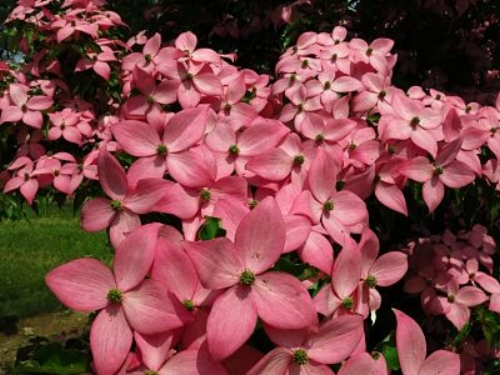Breeding a better dogwood
/'Scarlet Fire' dogwood Thomas Molnar/Rutgers University
No spring-blooming tree is more beloved in the Northeast than the dogwood and few suburban neighborhoods in New Jersey are without their frothy clouds of white and pink.
Native dogwoods are not without problems, though, and successive waves of insect and disease attacks spurred research into how to create healthier and more durable trees. The energetic quest for better dogwoods is a New Jersey story since key breakthroughs in breeding have come from research programs at Rutgers University in New Brunswick.
The release last year of ‘Scarlet Fire,’ the first deep pink Asian dogwood ever developed, was just the latest success of a decades-long project. Vividly colored with pointed bracts (the flower parts we commonly think of as “petals”), this dogwood blooms a month later than our natives and produces large, ornamental fruits that resemble strawberries.
“The breeding goal was a very dark pink,” says Thomas Molnar, an associate professor in Rutgers’ Plant Biology Department who is now heading up the dogwood program. “It took 50 years of breeding and hundreds of crosses to finally get the deep color we were after.”
Molnar is continuing work begun by the internationally noted breeder Elwin Orton, who put Rutgers on the map with his new holly and dogwood cultivars. Starting in 1965, Orton began by collecting named varieties of native dogwoods (Cornus florida) and Asian types (Cornus kousa), which were resistant to some of the natives’ chief enemies – borers, a fungus known as anthracnose and powdery mildew.
The breeding of woody ornamentals is a drawn-out process involving controlled “crosses,” or pollination of selected plants by the pollen of specific others. Hybrids between C. florida and C. kousa were tricky since the two bloom a month apart. Freezing genetic material from the former proved to be the solution, but results weren’t obvious until the new hybrids matured and bloomed – a process that spans 10 years, with another 10 to select and test the most promising of the lot.
The result was release in the early 1990s of the Stellar series of dogwoods representing a brand new type of dogwood, heavy-blooming and disease-resistant. These were 'Aurora,' 'Constellation,' 'Stardust' and 'Celestial,' all a creamy white; 'Ruth Ellen,' the brightest white, named for the wife of former Rutgers University President Edward Bloustein, and 'Stellar Pink,' with pink bracts that fade to a clean, unmuddied white.
'Venus' dogwood Thomas Molnar/Rutgers University
Next came an even more challenging project to cross Cornus kousa with Cornus nuttalli, a Pacific Coast species not reliably winter hardy in the Northeast. These produced the spectacular ‘Venus’ and ‘Starlight’ hybrids, released in 2004. ‘Starlight’ has a more columnar form, while ‘Venus’ is more round-headed and spreading. Unlike the four-petaled "flower" typical of other dogwoods, the blossom these trees bear is composed of five or sometimes six bracts. And they are huge, measuring nearly 8” x 8.”
Since Molnar came aboard in 2006, two years before Orton retired, new selections have kept coming from the by now extensive collection of complex crosses in the test fields in New Brunswick.
Newer releases include a variegated ‘Stellar Pink’ dogwood with leaves edged in creamy white that turn vivid shades of pink and purple in fall. Another is ‘Rosy Teacups’ with cupped blossoms and a rounded tree habit. ‘Red Pygmy’ is a true dwarf growing just seven feet tall at maturity and ‘Saturn’ is an especially heavy bloomer with white flowers.
These new dogwoods are patented and trademarked, generating royalties that are plowed back into research programs. The selected cultivars are propagated from the source tree (cloned, in other words) and grown by licensed nurseries for the trade and consumers. When you buy one of these saplings, you have in hand the end-product of some 50 years of science, research and experiment – with a bit of luck where open pollination by insects has been invited.
“Some plants are really mysteries since we’ve done genetic fingerprinting to identify one parents and aren’t sure of the other,” says Molnar. “There are more potential breakthrough coming and that’s what keeps me going in what’s really a very extended process. When a field of trees comes into bloom for the first time – well, that’s exciting. I say this every year now, but I can’t wait for May.”
PURCHASING INFO
A few New Jersey nurseries carry Rutgers’ dogwoods:
Good Earth Nursery, 257 Route 539, Cream Ridge, NJ 08514. Call 609-758-7500 or see goodearthnj.com. Retail and wholesale.
Rare Find Nursery, 957 Patterson Road, Jackson Township, NJ 08527. Call 732-833-0613 or see rarefindnursery.com. Retail sales on site and via mail order.
Pleasant Run Nursery, 93 Ellisdale Road, Allentown, NJ 08501. Call 609-259-8585 or see pleasantrunnursery.com. Sells wholesale only but also supplies spring plant sales at Frelinghuysen Arboretum, Morris Township; Rutgers Gardens, New Brunswick; and Van Vleck House & Gardens, Montclair.
For a complete list of mail order sources, see Rutgers’ list of licensees here.


